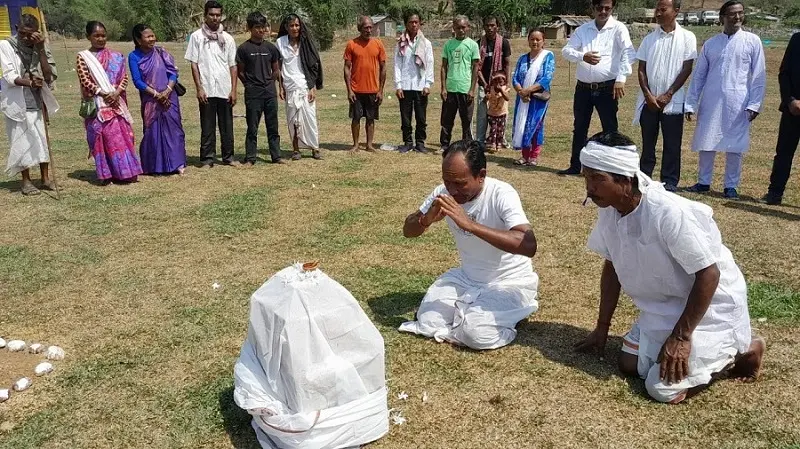“Jai Mandai! Jai Mandai Harini (Hail the Mandai race)!” A small assembled group shouted out in unison, pumping their clenched fists up in the air. They huddled in a circle surrounding a flag fluttering aloft on a bamboo pole that was pitched in an open field to pay homage to their ancestral deity, Garami, and the legendary Barman ruler Kumar Bhaskar Barman of the ancient kingdom, Kamarupa.
The crowd, including the visiting delegates, thereafter moved to a nearby stage and gathered under a makeshift shamiana. The occasion was the 5th inter-state annual conference of the All Mandai People’s Association (AMPA) held at Khamlai, a non-descript village under the Shella Block in the East Khasi Hills of Meghalaya bordering Bangladesh last week.
Seated on the dais were the invited guests from Bangladesh and other northeastern states along with AMPA chairmanPratap Barman, who introduced the visitors to the gathered audience. In his welcome speech, he highlighted the plight of the fragmented Mandai communities, especially their dying language.
“Aapnaraki Bengali, Assamese hoye bachtechan, naki Mandai hoye bachtechan (Are you going to live as a Bengalee or Assamese, or as Mandai people?)” He asked the crowd, ironically in Bengali language. Barman minced no words. “Most of us have forgotten our own language long ago, and with this, we got detached from our roots and lost our real identity. We have to reclaim our roots,” he exhorted the people.
Mandai is not a new found tribe; its ancestry can be traced to the ruling dynasties, beginning with the Barman reign. In the long 1400 years of history, the Mandai rulers and their people came under the influence of Hindu religion and majority of them were absorbed into the Hindu caste system and culture.
Barman said, following the Partition of India, the Mandai people are now found scattered all over, though under different identities (Koch, Hajong, Barman, Koch Rajbanshi etc) at Sylhet, Dhaka, Mymensing, Rangpur in Bangladesh and Kochbehar, Jalpaiguri (in North Bengal), Bodoland, Tezpur (in Assam), and in Meghalaya and Tripura.
Over the decades, in their struggle for survival, they also adopted new languages of the dominant communities and were assimilated into their socio-cultural systems.
Many of them now speak either some form of Bengali or Assamese, (Indo-Aryan group of languages, instead of Tibeto-Burman spoken earlier) depending on where they are settled.
“Unfortunately, due to illiteracy and lack of awareness and leadership, we have always been exploited politically, socially, and economically,” he rued. And unlike other tribes of northeastern region, “we also failed to assert ourselves as one of the indigenous communities and secure our rights as a Scheduled Tribe.”
Most of these communities are categorized as Scheduled Caste in West Bengal, and OBC in Assam. Koch and Hajong are treated as minor tribes in Meghalaya.
The tragedy is, Barman pointed out, “even if we spoke Bengali and wished to be accepted as Bengalees, we were snubbed as tribal; on the other hand, whenever, we wanted to associate ourselves with tribal communities, we were ridiculed as Bengalees.” So, “we are neither here nor there, we are nowhere people,” he lamented.
Reclaiming Mandai identity
For long, with loss of language the fragmented Mandai people have been suffering from identity crisis and different forms of deprivation and discrimination. “We need to organize and come together and reclaim our roots and lost heritage. There is no other way out!” He asserted.
In the past several years, Barman has been travelling to North Bengal, different parts of Assam, Meghalaya and Tripura and interacting with different communities, which claim their roots to the Garo-Koch lineage and belonging to the Tibeto-Burman group. He has also contacted similar communities in Bangladesh, which eventually led to the formation of AMPA. The organization has now separate chapters in each state and Bangladesh.
Since 2018, the AMPA has been holding an annual interstate conference of different communities which share the Mandai ancestry, and it had its first interstate conference at Pathorghat under the Shella block in Meghalaya.
There are about a dozen villages inhabited by Garo, Koch and Barman people in Shella and Balat areas of the East Khasi hills district on the Indo-Bangladesh border. Many of them do not have land and voting rights, and are often viewed as Bangladeshis even though they have been living there for generations.
The then Meghalaya speaker late Donkupar Roy who attended the conference had assured the Mandai people of addressing their grievances, including the demand for inclusion of the marginalized communities in the state list of the Scheduled Tribes, the AMPA chairman claimed.
Everything not yet lost
Barman said the old Mandai language, also known as Garo-Koch language, is still spoken by a small section of elderly population in some pockets both in Bangladesh and in North Bengal and other northeastern states of India. “We have to revive our dying language by teaching our children. That is the only way to unite our fragmented communities, restore our dignity and reclaim our indigenous identity as Mandaiharini,” he said.
Though the movement for revival of the Mandai identity is still in a nascent stage, “a good beginning has been made,” Dr. Paras Mani Singha, who was the chief guest at the conference, told the audience and hugely praised the ongoing efforts initiated through the annual AMPA conference.
“Koch-Rajbongshi, and Barmans are the different branches of the same root (Koch-Mandai). All Barmans belong to Koch or Koch-Rajbongshi community,” he stated, while cautioning that some vested interest groups may continue to drive a wedge among the communities.
Nonetheless, Dr. Singha said all these efforts have to continue while trying to bring all the fragmented groups under one umbrella as Mandai.
He also thanked the AMPA for honouring his father Dr. Purna Narayan Singha, former MP, with a title as the Matthaisa (great icon) of the Mandai people.















